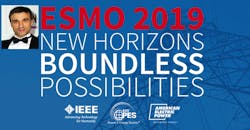ESMO 2019: Q&A With Nicolas Pouliot of Hydro-Québec
In today's fast-paced world, electric utilities are searching for ways to improve productivity and safety on the job site. One way that they are increasing the efficiency of their line crews is by using drones during line inspections. At ESMO 2019, from June 24-27 in Columbus, Ohio, attendees can learn about this technology during the technical conference.
Nicolas Pouliot of Hydro-Québec is one of the presenters for a session on rolling and flying robots and drones at ESMO 2019, which is hosted by American Electric Power and sponsored by IEEE PES. Learn more about his presentation in the Q&A below.
Q: How did you get involved with ESMO, and what are some benefits of being part of this year's conference?
A: I attended the 2006 ESMO conference in Albuquerque, New Mexico, where we first presented our early work on transmission line inspection robotics. At that time, being new to the field, I learned a lot about the tools and methods applied in transmission and distribution (T&D) maintenance. Since then, I have attended other T&D conferences throughout the world, and I look forward to being updated on the latest advancements in this field.
Q: Why should power industry professionals consider registering for ESMO this year?
A: I think that the technical content of this year’s edition will really cover some of the top priorities for the T&D industry, such as wildfire mitigation, health and safety and the uses of drones. ESMO is not a yearly event, so novelties and updates are likely to be featured.
Q: Describe your presentation on rolling and flying robots and how they share a role in advanced transmission line inspections. Can you give more details on what you plan to cover during your talk?
A: Here at Hydro-Québec, we have a really extended power grid and large territories to cover. We were proficient in the past at developing robotic technologies, along with several types of sensors that generate helpful data, contributing to asset management in our industry sector. The next identified goal was to develop technologies that are more simple to operate, and more efficient at deploying sensors directly onto the energized conductors. That is why LineRanger and LineDrone projects where launched, and several details about these technologies will be presented.
Q: Talk about how your company is using this technology to improve efficiency during line inspections.
A: So far these technologies are what we consider functioning prototypes, so we, as the development team, are still called upon to operate and deploy them on specific locations where they can prove their value, generate benefits and help build up a reliability record. We are now in the process of planning ahead the inside-training of our inspection or maintenance teams so that they can be in control of the technology in the near future.
Q: What are some special safety considerations or best practices that field crews should consider when using drone technology?
A: Drones are indeed flying robots and should be considered as regular aircraft. At Hydro-Québec, we take this statement very rigorously and comply with the Canadian regulations. This implies proper training with a log file of flying time for each pilot/drone, the advanced planning of an inspection task with a risk-mitigation plan, fencing the work zone on the ground and so on. To some extent, these safety measures are very similar to what line crews already use for their live-line work so integrating all of this goes smoothly.
Q: How did you get interested in a career in this industry?
A: My passion was always innovation and mechanism design. I loved to have the opportunity to start from a blank page while working and focusing on the actual needs of our industry partners and talking to experienced linemen, technicians, and field engineers. Through them, I came to discover the complexity of maintaining the power grid and assuring smooth and uninterrupted electricity to all, which we often take for granted. I am now quite proud to be active in that field.
Q: Talk about your training and education.
A: I am a mechanical engineer by training with a master's degree in mechanism design and robotics. In the early years of my career, I was involved in aerospace projects including flight simulators, jet engine design and full-scale aircraft test beds. I learned a lot in these projects about project management, team playing skills and tight schedules. I think that complemented my technical background.
Q: What are some highlights of your career so far?
A: I had the chance to personally field deploy the different technologies that we developed in more than 100 occasions, not only throughout the province of Québec, Canada, but in six different countries, where we established a partnership with different power utilities. This was exciting, but also enriching, as I came to realize that the same challenges, and the same passion at assuring the reliability of their transmission lines, exist worldwide.
Q: What do you see yourself doing in the future?
A: I firmly believe that the inspection and maintenance of robotic devices, including drones, will become more generalized in a certain future, and they will have a greater level of autonomy and dexterity. Artificial Intelligence (AI) is likely to play a role, and I think that I want to be part of the next chapter.
To listen to his presentation, register today for ESMO 2019. Don't miss your opportunity to earn professional development hours by attending the technical conference and learning about new technology during the trade show and outdoor demonstrations.
